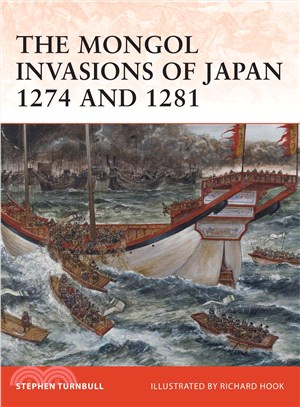The Mongol Invasions of Japan 1274 and 1281
商品資訊
系列名:Campaign
ISBN13:9781846034565
出版社:Osprey Pub Co
作者:Stephen Turnbull; Richard Hook (ILT)
出版日:2010/01/26
裝訂/頁數:平裝/96頁
規格:25.4cm*19.1cm*0.6cm (高/寬/厚)
商品簡介
作者簡介
相關商品
商品簡介
The two attempts by Khubilai Khan, the Mongol Emperor of China, to invade Japan in 1274 and 1281 represent unique events in the history of both countries. It pitted the samurai of Japan against the fierce warriors of the steppes who had conquered half the known world.
The Mongol conquest of Korea left them with a considerable quantity of maritime resources, which enabled them to thin seriously for the first time about crossing the Tsushima strait between Korea and Japan with an army of invasion. The first invasion, which began with savage raiding on the islands of Tsushima and Iki, made a landfall at Hakata Bay and forced the samurai defenders back inland. Luckily for the Japanese defenders, a storm scattered the Mongol invasion fleet, leading them to abandon this attempt.
In the intervening years the Japanese made defensive preparation, and the Mongol increased their fleet and army, so that the second invasion involved one of the largest seaborne expeditions in world history up to that time. This attempt was aimed at the same landing site, Hakata Bay, and met stiffer opposition form the new defences and the aggressive Japanese defenders. Forced buy a series of major Japanese raids to stay in their ships at anchor, the Mongol fleet was obliterated by a typhoon - the kami kaze (divine wind) - for the loss of as many as 90 per cent of the invaders. Although further preparations were made for an assault by the Mongols at the end of the 13ht and beginning of the 14th centuries, this proved to be the last realistic threat of an invasion of the home islands till 1945.
The Mongol conquest of Korea left them with a considerable quantity of maritime resources, which enabled them to thin seriously for the first time about crossing the Tsushima strait between Korea and Japan with an army of invasion. The first invasion, which began with savage raiding on the islands of Tsushima and Iki, made a landfall at Hakata Bay and forced the samurai defenders back inland. Luckily for the Japanese defenders, a storm scattered the Mongol invasion fleet, leading them to abandon this attempt.
In the intervening years the Japanese made defensive preparation, and the Mongol increased their fleet and army, so that the second invasion involved one of the largest seaborne expeditions in world history up to that time. This attempt was aimed at the same landing site, Hakata Bay, and met stiffer opposition form the new defences and the aggressive Japanese defenders. Forced buy a series of major Japanese raids to stay in their ships at anchor, the Mongol fleet was obliterated by a typhoon - the kami kaze (divine wind) - for the loss of as many as 90 per cent of the invaders. Although further preparations were made for an assault by the Mongols at the end of the 13ht and beginning of the 14th centuries, this proved to be the last realistic threat of an invasion of the home islands till 1945.
作者簡介
Stephen Turnbull took his first degree at Cambridge University, and received a PhD from Leeds University for his work on Japanese religious history. He has traveled extensively in Europe and the Far East and also runs a well-used picture library. His work has been recognized by the awarding of the Canon Prize of the British Association for Japanese Studies and a Japan Festival Literary Award. He currently divides his time between lecturing in Japanese Religion at the University of Leeds and writing.
主題書展
更多
主題書展
更多書展今日66折
您曾經瀏覽過的商品
購物須知
外文書商品之書封,為出版社提供之樣本。實際出貨商品,以出版社所提供之現有版本為主。部份書籍,因出版社供應狀況特殊,匯率將依實際狀況做調整。
無庫存之商品,在您完成訂單程序之後,將以空運的方式為你下單調貨。為了縮短等待的時間,建議您將外文書與其他商品分開下單,以獲得最快的取貨速度,平均調貨時間為1~2個月。
為了保護您的權益,「三民網路書店」提供會員七日商品鑑賞期(收到商品為起始日)。
若要辦理退貨,請在商品鑑賞期內寄回,且商品必須是全新狀態與完整包裝(商品、附件、發票、隨貨贈品等)否則恕不接受退貨。
























